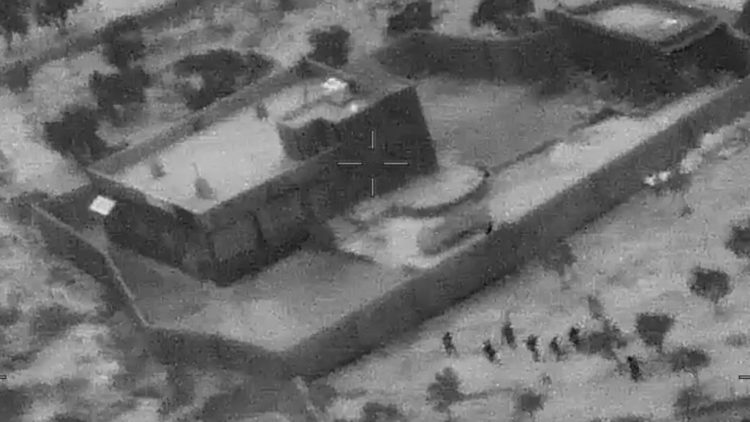Is this the best strategy in the War on Terror?
Like everyone else, we watched riveted as the Pentagon released video of the Special Operations Forces from the 1st SFOD – Delta, commonly known as Delta Force, taking down the compound of Abu Bakr al-Baghdadi.
And as much as everyone complained about President Trump’s comments, the material did have a video game or Hollywood film feel to it. But rest assured it was real and many people put their lives on the line in order to conduct this very dangerous operation.
When it comes to al-Baghdadi, no one in the West will shed a tear for his disappearance off the world stage. His fighters conducted countless atrocities in Iraq and Syria. He personally took part in the slavery of an American from “Doctors Without Borders”, who was kidnapped, kept as a sex slave and abused by him. She was later killed and ISIS tried to blame her death on a Jordanian airstrike.
Ibrahim al-Hashemi al-Qurayshi has been named as the new leader of ISIS after Baghdadi and his initial successor were killed in different missions by the United States’ military forces. No one knows much about al-Qurayshi, who during his released statement mentioned that ISIS is expanding.
Senator Ben Sase (R-NE), who is on the Senate Intelligence Committee, didn’t mince any words this week when he stated, “we killed the last murderous bastard who ran ISIS. Let’s go and get the next one.”
But this Baghdadi mission, as well as others, begs the question: is the targeting of terrorist leaders in these dangerous, and very time-consuming missions, the best strategy for combatting the war on terror?
Patrick B. Johnston wrote an article a few years ago on the subject of International Security and he argued that the targeting of the heads of terrorist organizations is indeed a sound strategy and laid out his points for continuing to undertake it. He called the strategy “Decapitation”, meaning to cut the head off the snake.
First, campaigns are more likely to end quickly when counterinsurgents successfully target enemy leaders. Second, counterinsurgents who capture or kill insurgent leaders are significantly more likely to defeat insurgencies than those who fail to capture or kill such leaders.
Third, the intensity of a conflict is likelier to decrease following the successful removal of an enemy leader than it is after a failed attempt. Fourth, insurgent attacks are more likely to decrease after successful leadership decapitations than after failed attempts. Additional analysis suggests that these findings are attributable to successful leadership decapitation and that the relationship between decapitation and campaign success holds across different types of insurgencies.
While this was written several years ago, the United States, as well as Israel, have followed this strategy of removing terrorist leaders. The Pentagon released a statement this week stating that the taking out of al-Baghdadi and his number two has created a power vacuum in ISIS leadership as the leaders beneath those two are much weaker.
However, the older and more established an organization is, the better it can withstand the loss of key leadership. Furthermore, there are many analysts who believe that targeting the heads of these terror organizations, while providing short-term favorable news broadcast propaganda by showing to the public that things can and will be done to erase the threat, doesn’t do much in deterring the organization overall.
Already have an account? Sign In
Two ways to continue to read this article.
Subscribe
$1.99
every 4 weeks
- Unlimited access to all articles
- Support independent journalism
- Ad-free reading experience
Subscribe Now
Recurring Monthly. Cancel Anytime.
In the case of al-Baghdadi, there are many in the intelligence world that believe that ever since the loss of his territory, he’d been only nominally issuing directives to the main body of ISIS. A frequent comment heard during the past week was that he (al-Baghdadi) was a “caliph without a caliphate.”
This is in direct contrast to Osama bin-Laden, who was continuing to issue directives to al-Qaeda, through his contact, from the Pakistan compound where he was in hiding.
For a long time the prevailing thought in the U.S. has been that taking out terrorist leaders helps to destabilize these terrorist organizations. But some of the data from certain areas seems to contradict this line of thought.
In Africa, the U.S. and its allies have long targeted the leadership of al-Shabbab, the al-Qaeda offshoot that operates in Somalia and other neighboring states. But if anything, al-Shabab is stronger now than it was a few years ago.
Much of the same can be said of al-Qaeda itself. Beside bin-Laden, the U.S. targeted, in 2006, the leader of al Qaeda’s Iraqi branch, Abu Musab Zarqawi and he was killed in an airstrike. In 2017, a U.S. drone strike killed the second-ranking Al Qaeda official in Syria, Abu Khayr Masri. And al-Qaeda remains strong.
Terrorist groups that are religion-based are the hardest to disrupt by targeting their leadership because their ideology, and thus their ability to recruit and grow, isn’t necessarily dependent on a leader.
Obviously, leadership in its purest form is a valuable and rare commodity. And the smaller a terrorist organization is, the smaller the leadership pool is. Therefore these “decapitation” missions may have a better and more lasting effect against smaller organizations. An example of this was the Shining Path (Sendero Luminoso) in Peru. After their leader Abimael Guzman was captured and sent to prison in the early 1990s, they splintered and were neutralized. But even they are making a comeback–albeit a small one.
That’s not to say that targeting the leadership is a waste of time and resources, but should be used more like a scalpel rather than a sledgehammer; and it’s not a panacea against every group.
While we can all be glad that al-Baghdadi is gone, this is far from the end of ISIS. Their numbers are strong and they are still a threat.









